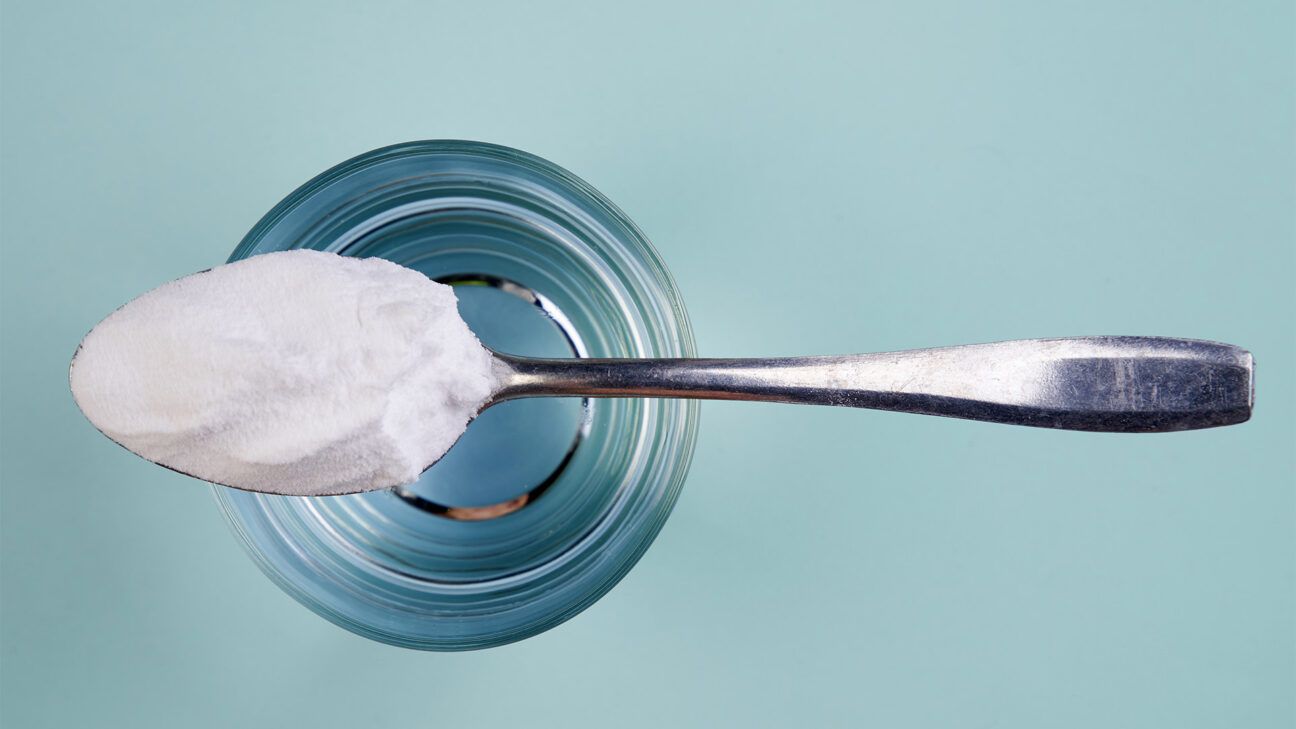6 Benefits of Baking Soda Water Trending on TikTok: What to Know

- Baking soda is generating discussions on TikTok because of its reported health benefits, including weight loss, endurance, and cancer risk reduction.
- Experts say that many of these claims are not supported by research and that consuming baking soda carries health risks.
- Experts stress the importance of speaking with a healthcare professional before trying this — or any —social media health trend at home.
Baking soda. You may have put it in the back of your fridge months ago to help prevent odors or recently used it as an ingredient in a recipe.
However, creators on TikTok are generating millions of views with claims that drinking a small amount of baking soda mixed into a glass of water can provide a number of health benefits, including aiding with weight loss, improving exercise endurance, and reducing cancer risks.
While several claims like these are going viral on social media platforms, health experts are raising concerns that there’s little evidence to back them up, and others can pose health risks.
Healthline spoke with registered dietitians to help explain exactly what baking soda is, as well as how it can react in your body, and how to separate fact from fiction about TikTok’s six most common reported health benefits that drinking it can provide.
What is baking soda
“Baking soda is a powder made up of a compound called sodium bicarbonate, also known as bicarb,” Destini Moody, RD, CSSD, LD, a registered dietitian at Garage Gym Reviews, said. “For those chemistry folks out there, it’s a salt that is composed of sodium and bicarbonate ions.”
Chris Mohr, PhD, RD, a fitness and nutrition advisor at Fortune Recommends Health, explained that its traditional use is to make dough rise.
“It works by reacting with acids to create bubbles of carbon dioxide,” Mohr says. “Besides baking, it’s also used for cleaning, deodorizing, and even as an antacid.”
Melanie Betz MS, RD, CSR, FAND, of The Kidney Dietitian, said that a key component of baking soda is where it falls on the pH scale, or in other words, a measure of how acidic something is on a scale of 0-14.
“A pH of 7 is neutral in terms of acid/base balance,” Betz said. “If a substance has a pH above 7, it is more basic or the opposite of acid. If it has a pH of less than 7, it is more acidic.”
She pointed out baking soda’s pH when dissolved in water, which is how those participating in many TikTok trends generally consume it, is around 8.5.
“[This indicates] it is a base and can help neutralize acid,” Betz said. ”The exact pH will depend on the concentration of how much baking soda was dissolved in water.”
And that’s important for several reasons, including, as Betz said, “If taken frequently, baking soda could increase the pH of your stomach, which could have detrimental effects on nutrient absorption.”
Six popular health claims associated with drinking baking soda water
Of the numerous health benefits circulating on TikTok that are currently being linked with drinking baking soda water, the experts that spoke with Healthline reported the following six are the most common:
Baking soda can improve exercise endurance and performance
Some evidence suggests that baking soda may help some people boost endurance.
A small 2021 randomized control trial of 11 trained male cyclists involved participants completing a stimulated cycling race for about three hours, with a 90-second “all-out sprint” at the end.
Results suggested that sodium bicarbonate supplementation could better someone’s all-out performance. A more extensive 2021 review indicated that ingesting sodium bicarbonate might boost performance during high intensity activities like running or cycling lasting up to 12 minutes.
However, Mohr said this claim requires more nuance than is usually provided in TikTok posts.
“Baking soda can help athletes by reducing acid buildup during intense exercise, which might improve performance,” Mohr said. “Its effectiveness varies from person to person, and too much can actually cause serious GI distress, so it’s important to consult with a qualified sports dietitian before considering it.”
Baking soda can help reduce indigestion
A 2022 review indicated that sodium bicarbonate might help relieve heartburn short term.
“Reflux is caused by your stomach acid splashing up into your esophagus,” Betz explained. “Taking baking soda would temporarily reduce acid levels in your stomach and help the symptoms of reflux.”
However, Mohr emphasized “temporarily.”
“It’s only a short-term fix and shouldn’t be used frequently and without consulting with a healthcare practitioner for dosing,” he said.
Baking soda can help with weight loss
Every dietitian who spoke with Healthline cautioned that there’s no data that supports this claim.
“There is no reliable research to support baking soda can help with weight loss,” Moody said. “The one mechanism in which this may be possible is taking baking soda in amounts that cause so much stomach upset that an individual no longer has an appetite.”
Which, Moody noted, is not only dangerous, but would still not result in sustainable weight loss.
Baking soda can help slow the progression of chronic kidney disease
Some research, including a 2021 review, suggests sodium bicarbonate might assist with slowing down chronic kidney disease progression.
More recently, an American Journal of Medicine randomized-control trial published on Aug. 5, 2024, indicated that taking two oral doses of baking soda daily (four to five 650-mg tablets) could slow kidney disease progression over five years but did not link intake with lower blood pressure or cardiovascular disease risk reduction.
Betz explained that the kidneys are tasked with helping the body maintain pH levels.
“They do a really good job at it,” Betz said. “If you do not have kidney disease, your kidneys are probably doing a perfect job of getting rid of all the extra acid in your body. There is no need to try to reduce body acid levels and no data to suggest that taking baking soda will help prevent kidney disease.”
However, if the body’s pH gets too high or low, it cannot function correctly, and the risks can be fatal. Taking baking soda to improve kidney function isn’t a cure-all.
“If you do have kidney disease, your kidneys may not be able to get rid of acid as well, and acid can build up in your body, causing acidosis, which has a negative impact on your bones and kidneys,” Betz said. “Acidosis is closely monitored in kidney disease, and medications, including sodium bicarbonate — aka baking soda — pills are prescribed.”
Betz said it’s critical to discuss consuming baking soda with a healthcare professional to assess your acid levels before trying this therapy at home.
Baking soda can help reduce your risk of cancer
A 2020 minireview suggested that baking soda might have anticancer properties but called for a large-scale clinical trial.
“Tumors survive best in an acidic environment, so many believe that making the body more alkaline by consuming things like baking soda can help treat malignant tumors,” Moody said. “However, the only studies done to support this claim have been in animals, and it is honestly so irresponsible to urge people with cancer, who don’t have time to waste on treatment, to seek any other treatment besides those that are firmly supported by rigorous research.”
Baking soda can help lower inflammation
A 2018 study consisting of rat and human participants suggested that baking soda might reduce inflammation. But, the registered dietitians Healthline spoke with say the study is not enough to endorse using baking soda for reducing inflammation, which can raise a person’s risk for diseases like cardiovascular and Alzheimer’s.
“One two-week study found that drinking baking soda may reduce inflammation, but that is a trial not nearly long enough to warrant a recommendation,” Moody said. “Alkalinity has an ability to reduce inflammation in the body, which is likely where this claim came from. However, this principle only applies to whole foods like fruits and vegetables, foods that are alkaline in nature, that are already known to help prevent inflammation.”
The risks of drinking baking soda water
Consuming baking soda, particularly in high quantities, can pose significant health risks.
One teaspoon of baking soda contains about 1,200 mg. of sodium, nearly the full daily recommended allotment given by the American Heart Association (AHA) for people with high blood pressure (1,500 mg).
The AHA suggests that most healthy adults consume no more than 2,300 mg of sodium daily.
Experts Healthline spoke with say that risks of consuming too much baking soda, especially regularly, include:
- Bloating
- Vomiting
- Cramping
- Electrolyte imbalances
- Hypertension
- Nutrient absorption difficulties
Moody also stressed the importance of being skeptical about any health trend circulating on social media platforms like TikTok.
“Nearly all users of the platform are there for the goal of getting views and going viral,” said Moody. “Novel and unconventional things, like drinking baking soda, are often promoted because people will click and view out of curiosity.”
“People trying to go viral do not have your health and safety in mind,” Moody added. “They also lack the knowledge and responsibility to caution others to seek medical advice before trying supplementation like this, especially for individuals who are pregnant, breastfeeding, or suffering from a chronic disease that may be exacerbated by ingesting compounds like baking soda.”
Takeaway
While social media is abuzz about using baking soda to lower the risks of some diseases, achieve weight loss, and improve exercise performance, registered dietitians warn that the research is murky (and, in some cases, non-existent).
Moreover, some people — like those with chronic kidney disease or hypertension — may see their condition worsen.
Additionally, baking soda can cause GI upset, such as cramping and bloating.







